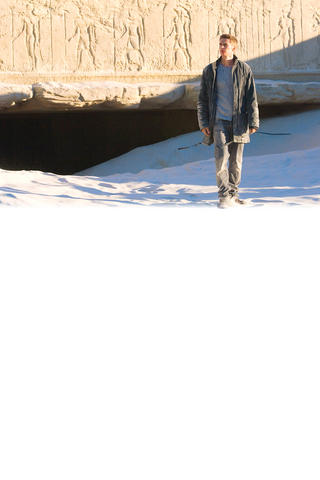In a battle waged with popcorn, floodlights, chalk and star power, science and art squared off in a lecture hall at the Massachusetts Institute of Technology one recent evening.
On one side of a vaunted cultural divide were Doug Liman, director of Jumper, about a young man who discovers he can transport himself anywhere he wants just by thinking about it, and Hayden Christensen, the film's star.
On the other were a pair of the institute's physics professors, Edward Farhi and Max Tegmark, experts on the type of physics the movie was purporting to portray, who had been enlisted to view a few scenes from it and talk about science.

PHOTO COURTESY OF BVI
In the middle were hundreds of MIT students who had waited for hours to jam into a giant lecture hall known as Room 26-100 and who proved that future scientists and engineers could be just as rowdy and star-struck as the crowds outside the MTV studios in Times Square.
"I guess I wasn't expecting such a lively group," Christensen said.
The evening was the brainchild of Warren Betts, a veteran Hollywood publicist who has helped promote a number of movies with scientific or technological themes, including Apollo 13. "Hollywood has gotten much smarter about bringing scientists in," said Betts, who said he had gotten excited after a Caltech physicist told him that teleportation was actually an accomplished fact in the quirky realm of quantum physics.

Betts arranged for clips from the movie to be shown, and then inveigled Farhi, an expert on quantum computers, and Tegmark, a cosmologist, to participate in a panel discussion, for an undisclosed fee. They agreed, as long as they could talk about real physics.
"What do I know about movie production?" asked Farhi, who pronounced himself "clueless." He said, "If the students learn something, it's fine, I'm happy."
The corridor outside MIT's venerable lecture hall was transformed for the occasion into a red carpet - sans the actual red carpet - lined with television cameras and reporters. At the appointed hour, Christensen, who played the young Anakin Skywalker in Star Wars Episode II: Attack of the Clones, and Star Wars Episode III: Revenge of the Sith, began to proceed slowly down the line.
Liman, the director, meanwhile, confessed to being nervous. "We're about to see a couple of MIT professors rip me to shreds," he said. "I hope they appreciate that I tried to respect the physics of the planet we live on."
Liman, who directed The Bourne Identity, and Mr. and Mrs. Smith, said he had been a "physics prodigy" in high school, which had gotten him into Brown University despite a checkered adolescence. He never took a physics class in college, however. "Being good at it made it a little boring," he said.
He said he had fallen in love with the Jumper script - adapted by David S. Goyer, Jim Uhls and Simon Kinberg from a series of young adult novels by Steven Gould - because of its honesty. The first thing the new superhero does with his powers is rob a bank.
"The story was as honest as it could be," Liman said.
He said he had spent a lot time trying to figure what teleportation would actually look like, never mind what causes it. If a body suddenly disappeared, for example, there would be a rush of air into the vacuum left behind.
Physics, Liman said, is more connected to filmmaking than one might expect. "I liked problem solving," he said. "A film," he added, "is one big problem."
An hour later, Farhi and Tegmark, true to their words, let the air out of the Jumper balloon.
In real experiments recently, Farhi told the movie fans, physicists had managed to "teleport" a single elementary particle, a photon, which transmits light, about one and a 2.4km, "a little less exotic than what you see in the movie."
What is actually teleported in these experiments, he explained, is not the particle itself but all the quantum information about the particle.
To accomplish this is no small matter. Among other things, the teleporters have to create a pair of so-called entangled particles, which maintain a kind of spooky correlation even though they are separated by light years. Both of them exist in a kind of quantum fog of possibility until one or the other is observed. Measuring one particle instantly affects its separated-at-birth twin no matter how far away. If one is found to be spinning clockwise, for example, the other will be found to be spinning counter clockwise.
In order to use this magic as a quantum telegraph wire to teleport the information about a third particle, Farhi emphasized, you have to send a conventional signal between the entangled twins, and that takes time, according to Einstein. "You cannot get that thing over there faster than the speed of light," Farhi said, to cheers from the crowd.
The real lure, he said, is not transportation, but secure communication. If anybody eavesdrops on the teleportation signal, the whole thing doesn't work, Farhi said. Another use is in quantum computing, which would exploit the ability of quantum bits of information to have different values, both one and zero, and at the same time to perform certain calculations, like factoring large prime numbers, much faster than ordinary computers.
As Tegmark said, "Nobody can hack your credit card, and then you can build a quantum computer and hack everybody else's card."

We lay transfixed under our blankets as the silhouettes of manta rays temporarily eclipsed the moon above us, and flickers of shadow at our feet revealed smaller fish darting in and out of the shelter of the sunken ship. Unwilling to close our eyes against this magnificent spectacle, we continued to watch, oohing and aahing, until the darkness and the exhaustion of the day’s events finally caught up with us and we fell into a deep slumber. Falling asleep under 1.5 million gallons of seawater in relative comfort was undoubtedly the highlight of the weekend, but the rest of the tour

Youngdoung Tenzin is living history of modern Tibet. The Chinese government on Dec. 22 last year sanctioned him along with 19 other Canadians who were associated with the Canada Tibet Committee and the Uighur Rights Advocacy Project. A former political chair of the Canadian Tibetan Association of Ontario and community outreach manager for the Canada Tibet Committee, he is now a lecturer and researcher in Environmental Chemistry at the University of Toronto. “I was born into a nomadic Tibetan family in Tibet,” he says. “I came to India in 1999, when I was 11. I even met [His Holiness] the 14th the Dalai

Following the rollercoaster ride of 2025, next year is already shaping up to be dramatic. The ongoing constitutional crises and the nine-in-one local elections are already dominating the landscape. The constitutional crises are the ones to lose sleep over. Though much business is still being conducted, crucial items such as next year’s budget, civil servant pensions and the proposed eight-year NT$1.25 trillion (approx US$40 billion) special defense budget are still being contested. There are, however, two glimmers of hope. One is that the legally contested move by five of the eight grand justices on the Constitutional Court’s ad hoc move

Stepping off the busy through-road at Yongan Market Station, lights flashing, horns honking, I turn down a small side street and into the warm embrace of my favorite hole-in-the-wall gem, the Hoi An Banh Mi shop (越南會安麵包), red flags and yellow lanterns waving outside. “Little sister, we were wondering where you’ve been, we haven’t seen you in ages!” the owners call out with a smile. It’s been seven days. The restaurant is run by Huang Jin-chuan (黃錦泉), who is married to a local, and her little sister Eva, who helps out on weekends, having also moved to New Taipei